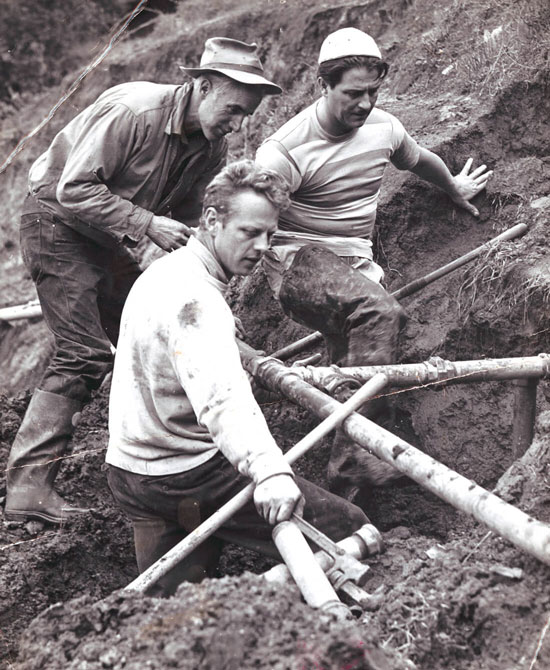The Stone House, Part 5: ‘Lee Conger and the Topanga Riders’Pablo Capra | |
The Stone House, Part 5: ‘Lee Conger and the Topanga Riders’Pablo Capra In 1946, the stone house and ranch comprised 30 acres, with four acres for apple trees and a quarter acre for tomatoes. The “huge kerosene chandeliers swing[ing] from the arched ceiling” had finally been modernized with electricity.
Two generations of the same family moved onto the property. Lee (1905-1964) and Dora Conger (1908-1981) were the younger couple. Dora’s parents, John (1861-1961) and Iva Heron (1871-1948), will be discussed in the next chapter.
Lee and his brother Marc had first moved to Old Topanga in 1925, when they were 20 and 19, probably drawn to the Bonnell Park development. Lee worked as a secretary for a “movie star,” perhaps cowboy actor Richard Dix (1893-1949), who also moved to Topanga in 1925. Marc worked as a “laborer” and later moved to Observation Dr. in Fernwood.
In the 1930s, Lee married Dora, who grew up in Topanga. The couple moved to Fullerton, CA, where Lee became a fireman. When they returned in 1946, he got a job at William’s Topanga Hardware in Old Canyon.
Lee involved himself in many civic projects.
He supplied well water to Old Canyon’s newly formed Topanga Park Mutual Water Company, and became one of its directors. Water shortages would continue to be a major issue until Los Angeles’ pipeline finally delivered to Topanga in 1968. Lee spoke at one water meeting that “rapidly passed beyond the ‘talking’ stage to become a verbal free-for-all that was immensely enjoyed by nearly 100 persons in attendance....”
On a bad day, tempers ran hotter.
“Vandalism... was repeated in Topanga when the words VOTE NO in large letters on an 8-ft sign, placed on the Cy Wood property on Old Canyon Road, were painted over. In addition, Wood’s electric fence was torn down and a steel post bent almost double, allowing Wood’s horses to wander loose.”
(“Vandalism Against Bond Opponents Again Marks Water Election,” Topanga Journal, 1960-06-30)
Lee joined the Chamber of Commerce’s Fire Prevention Committee, but failed to prevent a fire in his own home in 1947. The fire started in the soot of his wood stove’s chimney. Firemen arrived quickly, and stopped the flames from spreading to the rest of the stone house.
Several Old Canyon residents, including Lee, signed oil drilling leases on their properties, which meant that they would get a royalty if oil was ever found. Hopes were high, but thankfully oil fields were not in Topanga’s future.
“It was said that the [Topanga Leasing Corp.] was paying $1 per month per acre on leases with the proviso that drilling must start within seven months.... Moreover, several reports are current that oil has been encountered in drilling water wells.... Although the situation has not caused anyone to order a Cadillac as yet....”
(“Old Canyon Residents Sign Oil Leases,” Topanga Journal, 1951-04-20) Lee Conger, Bill Sloan, and Jerry Harold lay a water line in the 1940s near the junction of Old Topanga Canyon. |
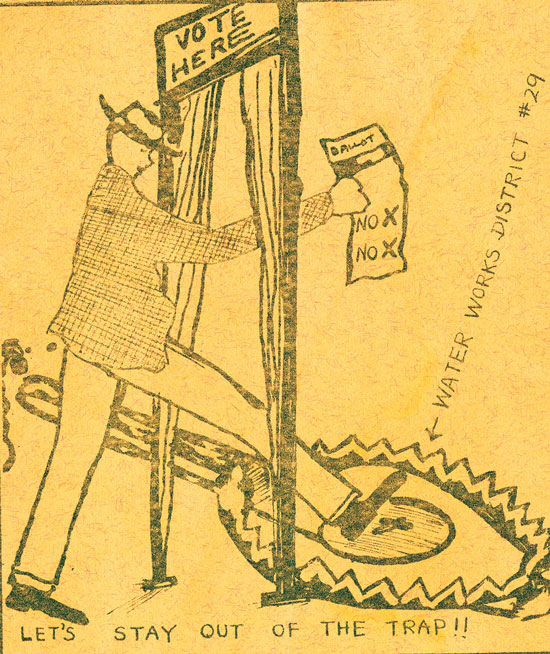 Photo c/o the Topanga Historical Society As the secretary of the Topanga Property Owners Association, Lee worked on revising Topanga’s zoning laws to prevent the building of a sanitarium for mental cases and drug addicts in 1952.
He was also devoted to his hobbies.
He belonged to the International Federation of American Racing Pigeon Fanciers, and distributed their literature at his hardware store. In 1947, he founded the Topanga Pigeon Club.
Menaced by hawks and hunters, he threatened to prosecute the latter if they interfered with his pigeon racing, which he called “one of the few remaining true sports.”
The Congers belonged to the Topanga Riders Club and owned at least two horses, a sorrel and a palomino. The Riders had barbecues, rode in the moonlight, camped out, and took trips to places like Saddle Peak Lodge.
| 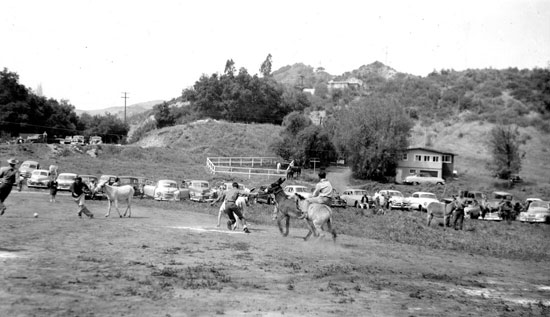 The Riders and the Legionnaires played a rematch to determine ‚Äúwho slickered who‚Äù after tying in the first game. In January 1953, Lee opened his property to 500 attendees of a Donkey Baseball game as a March of Dimes fundraiser for polio. ‚ÄúDonkey baseball has a national reputation and appears in Topanga for the first time,‚Äù wrote the¬ÝTopanga Journal¬Ý(1953-01-16).
The “most assinine game in the world” began with a parade by the Riders in “their newly adopted official garb of red shirts, blue denims and gray hats.”
Master of Ceremonies and Topanga Chamber of Commerce President Orville Rainey spoke, introducing visiting dignitaries and polio victims.There was an animal show put on by trainer Buster Richardson (who had supplied the donkeys), and an auction for riding equipment.
Then the Donkey Cowboys (the Riders) played the Tin Soldiers (the American Legion). Except for the pitcher and catcher, everyone had a donkey. The batter swung on his feet but jumped onto a donkey to round the bases. The game ended in a tie.
| 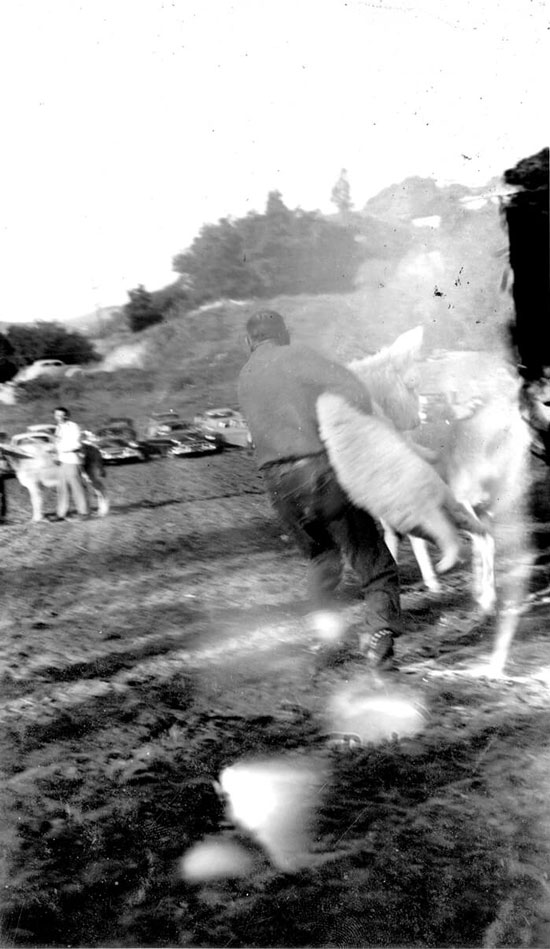 Photo c/o Topanga Historical Society, January 25, 1953 A rematch was played in April 1953, this time as a fundraiser to build the Legionnaires’ new clubhouse. Curiously, part of the money was also used “to pay taxes on Bonnell Park for the 60 or more owners who have allowed them to become delinquent.”
Trash-talking was part of the fun of Donkey Baseball. The Riders declared that “it would be a pleasure to skunk the soldiers again,” while the Legionnaires insisted that “this time the Legion will hire its own scorekeeper and use its own chalk.”
Their rematch, to determine “who slickered who,” was “punctuated with side-splitting laughter”... and sometimes just side-splitting.
“Black and Blue and bruised all over, these gallant gentlemen galloped the grounds for nine innings to give the Legionnaires a victorious score of 1 to 0 and the sticks to start their clubhouse....
“There were cheers for Ray Alley who couldn’t be unseated even though he was carried to the very edge of the outfield.... The merriment was momentarily marred when Russ Gillespie (Riders Club) was kicked in the ribs by his mount, however, he was game enough to play the very last inning....
“The most picturesque pitcher on a baseball diamond was George Law, who was dressed in dashing duds of the vintage worn by such gay caballeros as Autry, Rogers and Williams. Also riding the little rascals in an attempt to retrieve the score for the Riders were Jim Rickman, Al Sehmeyer and Lee Conger. Telling a tale of torment are Jim Buerckel and Ron Bouseman, who found out that the terra was never more firma.”
(“Canyon Carousel,” Topanga Journal, 1953-05-01)
In 1949, Lee’s father-in-law John Heron sued him, demanding a partition of their property and the money that he’d lent the Congers to buy the ranch. The ranch was divided, with John getting 14.5 acres and the stone house, and the Congers getting the portion in Bonnell Park.
Pablo Capra is the Archivist for the Topanga Historical Society and author of “Topanga Beach: A History” (2020). More at topangahistoricalsociety.org.  | 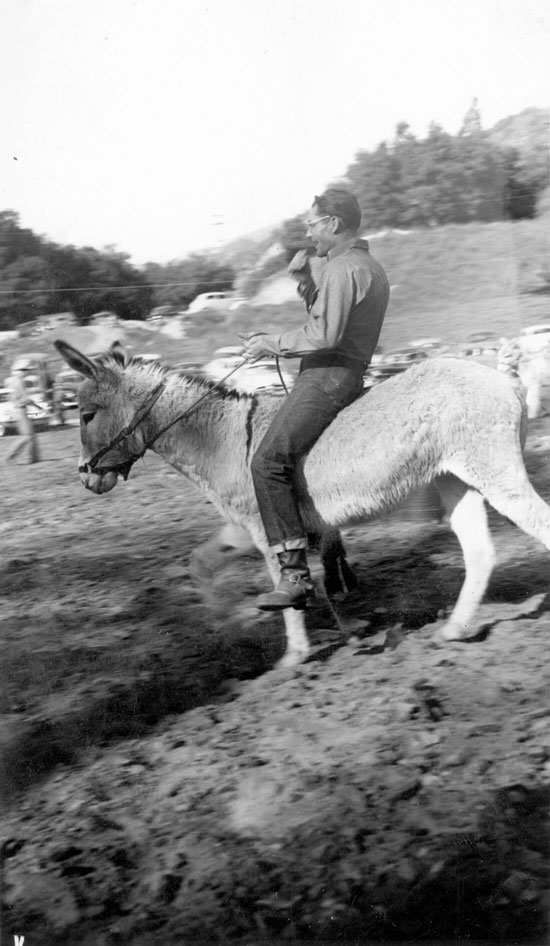 Above: Jim Buerckel got a big laugh by carrying his donkey around the bases. Left: Ron Bouseman “found out that the terra was never more firma” when his donkey bucked him. | | | | | | | | | | | |
|
|
|
|
|
|
|
 |
|
|
|
| | |
|
|




